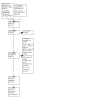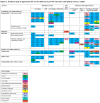Approaches for delivery of refractive and optical care services in community and primary care settings
- PMID: 38808577
- PMCID: PMC11134311
- DOI: 10.1002/14651858.CD016043
Approaches for delivery of refractive and optical care services in community and primary care settings
Abstract
Background: Uncorrected refractive error is a leading cause of vision impairment which, in most cases, can be managed with the appropriate spectacle correction. In 2021, the World Health Assembly endorsed a global target of a 40-percentage-point increase in effective coverage of refractive error by 2030. To achieve this global target, equitable access to refractive and optical services within community and primary care settings needs to be strengthened. This review will inform the development of technical guidance to support improvements in the testing and correction of refractive error among World Health Organization (WHO) member states.
Objectives: To determine the range of approaches for delivery of refractive and optical care services in community and primary care settings, and the methods employed for their evaluation.
Search methods: We searched CENTRAL, MEDLINE, Embase and Global Health databases, grey literature, and annual reports and websites of relevant organizations involved in eye-care delivery from January 2002 to November 2022 to identify approaches for refractive and optical service delivery.
Selection criteria: We included observational and interventional studies, reviews, and reports from relevant organizations related to delivering refractive services and optical services for preschool and school-aged children and adults in community and primary care settings published between January 2002 and November 2022. We searched for studies and reports published within the last 20 years because vision impairment due to uncorrected refractive error has only recently become a public health and eye health priority, therefore we did not expect to find much relevant literature until after 2002.
Data collection and analysis: Two review authors screened titles, abstracts and full texts, and extracted data. We resolved any discrepancies through discussion. We synthesized data, and presented results as tables, figures, and case studies. This project was led by the World Health Organization (WHO) Vision and Eye Care Programme.
Main results: We identified 175 studies from searches of databases and grey literature, 146 records from company reports, and 81 records from website searches of relevant organizations that matched our inclusion criteria. Delivery approaches for refractive and optical services in community care included school-based, pharmacy, and outreach models, whereas primary care approaches comprised vision centre, health centre, and a combination of vision or health centre and door-to-door delivery. In community care, school-based and outreach approaches were predominant, while in primary care, a vision-centre approach was mainly used. In the WHO African region, the school-based and outreach approaches were mainly reported while, in the Americas, the outreach approach was mostly used. Very few approaches for service delivery were reported in the WHO Eastern Mediterranean region. Prominent gaps exist in the evaluation of the approaches, and few studies attempted to evaluate the approaches for delivery of refractive and optical care services.
Authors' conclusions: We comprehensively describe a range of approaches for delivery of refractive and optical services in community and primary care. Further evaluation of their effectiveness will better inform the application of these service-delivery approaches. The study outcomes will help guide WHO member states in strengthening refractive and optical services at community and primary care levels.
Funding: This scoping review was supported by the Vision and Eye care Programme, World Health Organization and ATscale Global Partnership.
Registration: The protocol of this scoping review was published in the Open Source Framework.
Copyright © 2024 The Authors. Cochrane Database of Systematic Reviews published by John Wiley & Sons, Ltd. on behalf of The Cochrane Collaboration.
Conflict of interest statement
Valerie Umaefulam: no conflict of interest Safi Sare: no conflict of interest Gareth Lingham: no conflict of interest Iris Gordon: no conflict of interest Andreas Mueller: no conflict of interest Neha S. Krishnam: no conflict of interest Vera L Alves Carneiro: no conflict of interest Mitasha Yu: no conflict of interest Jennifer R Evans is an investigator of one of the included studies [72] Stuart Keel: no conflict of interest
Figures



Similar articles
-
Signs and symptoms to determine if a patient presenting in primary care or hospital outpatient settings has COVID-19.Cochrane Database Syst Rev. 2022 May 20;5(5):CD013665. doi: 10.1002/14651858.CD013665.pub3. Cochrane Database Syst Rev. 2022. PMID: 35593186 Free PMC article.
-
Effects of consumers and health providers working in partnership on health services planning, delivery and evaluation.Cochrane Database Syst Rev. 2021 Sep 15;9(9):CD013373. doi: 10.1002/14651858.CD013373.pub2. Cochrane Database Syst Rev. 2021. PMID: 34523117 Free PMC article.
-
Education support services for improving school engagement and academic performance of children and adolescents with a chronic health condition.Cochrane Database Syst Rev. 2023 Feb 8;2(2):CD011538. doi: 10.1002/14651858.CD011538.pub2. Cochrane Database Syst Rev. 2023. PMID: 36752365 Free PMC article.
-
Consumers' and health providers' views and perceptions of partnering to improve health services design, delivery and evaluation: a co-produced qualitative evidence synthesis.Cochrane Database Syst Rev. 2023 Mar 14;3(3):CD013274. doi: 10.1002/14651858.CD013274.pub2. Cochrane Database Syst Rev. 2023. PMID: 36917094 Free PMC article.
-
Laser-assisted subepithelial keratectomy (LASEK) versus photorefractive keratectomy (PRK) for correction of myopia.Cochrane Database Syst Rev. 2016 Feb 22;2(2):CD009799. doi: 10.1002/14651858.CD009799.pub2. Cochrane Database Syst Rev. 2016. PMID: 26899152 Free PMC article.
Cited by
-
Molecular mechanism of hypoxia and alpha-ketoglutaric acid on collagen expression in scleral fibroblasts.Int J Ophthalmol. 2024 Oct 18;17(10):1780-1790. doi: 10.18240/ijo.2024.10.03. eCollection 2024. Int J Ophthalmol. 2024. PMID: 39430015 Free PMC article.
References
-
- World Health Organization. Report of the 2030 targets on effective coverage of eye care. Available from https://www.who.int/publications/i/item/9789240058002 2022. [WEBSITE: https://www.who.int/publications-detail-redirect/9789240058002 (accessed 8 Oct 2023)]
-
- Lamoureux EL, Wang J, Aung T, Saw SM, Wong TY. Myopia and quality of life: The Singapore Malay Eye Study (SiMES). Investigative Ophthalmology & Visual Science 2008;49(13):4469. - PubMed
-
- Nie J, Pang X, Wang L, Rozelle S, Sylvia S. Seeing Is believing: experimental evidence on the impact of eyeglasses on academic performance, aspirations, and dropout among junior high school students in rural China. Economic Development and Cultural Change 2019;68(2):335-55.
Publication types
MeSH terms
Grants and funding
LinkOut - more resources
Full Text Sources
Medical

